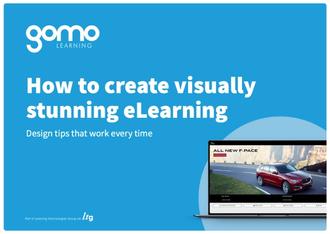How to grab and hold your online learners' attention: 8 elements to include into your eLearning course design
Let's face it, some eLearning courses are boring and bland. The fact that many online learners have short attention spans doesn't help either. Combine the two, and you get low online learner retention rates and diminished eLearning ROI. Fortunately, there are ways to captivate and inspire your audience by appealing to their visual sensibilities and emotions. Here are eight eLearning course design elements that are sure to grab your online learners' attention and keep them glued to their screens.
1. Eye-catching infographics
Infographics blend text with visuals to highlight an important topic, trend or task. For example, they may include creative fonts, graphics, and charts to explore a noteworthy compliance issue. In most cases, infographics feature statistics and need-to-know facts accompanied by icons or pictures. Each section of the graphic focuses on a single idea or concept so that online learners can absorb the information before moving their gaze downwards. The secret is to create a separate infographic for each topic to prevent cognitive overload. Also, leave some space between each stat and fact to adhere to the "law of proximity".
2. Bold color palettes
Colors have emotional significance. As such, it's important to choose the right color scheme for your eLearning course design. What mood are you trying to achieve? Do the colors provide enough contrast or do they simply blend into the background? To grab online learners' attention, incorporate bold color schemes that convey the right tone. These hues should also align with your brand image in order to create a sense of cohesion. Lastly, avoid color palettes that distract online learners' attention from the takeaways. For instance, neon green or hot pink shades that catch their eye in a bad way.
3. Compelling imagery
Intriguing images stir emotions and spark online discussions. They also help to simplify complex ideas and topics. There are a couple of caveats to using vivid imagery in your eLearning course design, however. Firstly, you must ensure that the images are appropriate for your audience. You must take the online learners' cultural background and geographical location into account. It's also wise to avoid controversial images that are polarizing. The goal is to grab online learners' attention, not to offend their personal beliefs. Finally, only use images that are relevant to the subject matter. Otherwise, you may end up with a cluttered eLearning course design that provides little real-world value.
4. Interesting eLearning characters
Incorporate character cut-outs and images to give your eLearning course narrator a visual persona. The secret is to find relatable and relevant images that foster a personal connection with your online learners. For example, a man dressed in business attire may be ideal for your leadership online training. You should also include eLearning characters in different poses and settings to make them even more dynamic.
5. Interactive multimedia
Modern learners expect exciting things from an eLearning course. They want an eLearning experience that makes the most of tech tools and visual aids. Here are just a few interactive multimedia elements you may want to consider:
- Simulations
Simulations facilitate practical experience and know-how. Online learners enjoy being able to apply their skills and test out different approaches. Thus, they are more likely to stick around and reap the rewards of your eLearning course. One of the most effective uses of virtual simulations is task walkthroughs. Online learners can explore each step instead of just reading about it. - Branching scenarios
Branching scenarios include different decision-making routes that online learners must choose from. In order to achieve the desired outcome, they have to utilize preexisting knowledge, skills, and experience. As a result, they're able to see the consequences of their actions and behaviors first-hand without having to deal with real-world risks. - Online presentations
Online presentations can feature a broad range of media, from background music and sound effects to images and character cut-outs. It's best to create microlearning presentations that center on a specific topic or skill. That gives online learners the power to absorb the information whenever it's most convenient. There is a variety of rapid eLearning authoring tools that allow you to create multimedia-rich presentations with no prior experience.
6. Branded eLearning templates
Create reusable eLearning templates that feature your brand logo, color scheme, and font types. They make your entire eLearning course design look more polished and professional. Thus, every component has the power to grab online learners' attention without getting lost in the shuffle. Branded eLearning templates are also eye-catching in their own right. Especially if you include high quality borders, graphics, headers and other visually striking elements.
7. Video demos
A well-produced eLearning video conveys the key concepts as quickly as possible. Online learners can observe favorable behaviors and see skills in action. Thus, they can apply the information in real-world settings. Video demos are ideal for product knowledge, compliance training, as well as complex tasks. You can even create an animated video to boost the entertainment value.
8. Story-based serious games
Serious games are naturally engaging and entertaining. They give online learners the chance to explore the subject matter by embarking on adventures and defeating foes. However, if you want to achieve maximum emotional interactivity, you need to frame it with a compelling story. Include interesting eLearning characters, relatable challenges, and creative plot twists that spark their imagination.
These eLearning course design elements pull online learners into the eLearning experience and create an emotional connection. Each component contributes to the overall eLearning conditions in order to foster a positive, inspirational, and engaging eLearning experience. It's also crucial to continually reevaluate your eLearning course design so that you always provide fresh and memorable eLearning course content.
About the author: Christopher Pappas
Christopher Pappas is the Founder of eLearning Industry Inc, which is the leading publishing platform that delivers inspiring, industry-specific content to eLearning professionals. Christopher holds an MBA and an MEd (Learning Design) from BGSU.


